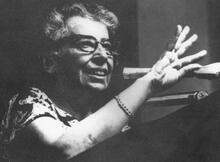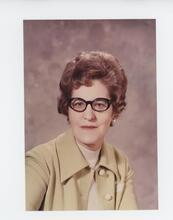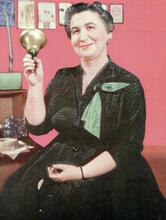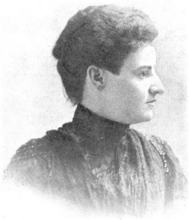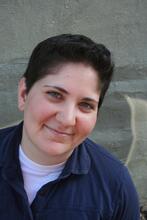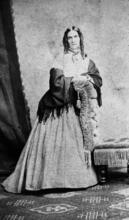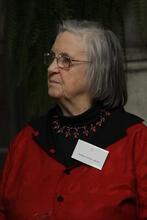Ruth Nanda Anshen
Ruth Nanda Anshen connected the great thinkers of different fields, offering them opportunities to explain their work to each other and the general public. While studying for her PhD at Boston University in the late 1930s, Anshen was distressed to realize how the masters of various disciplines seemed unaware of each other’s work and how it might affect their own. She began editing the Science of Culture series in 1940, which for two decades brought together essays by luminaries as varied as Albert Einstein, Margaret Mead, Jonas Salk, and Thomas Mann, in hopes of creating a unified theory to explain the workings of the universe though a cross-pollinating, multidisciplinary approach. Throughout her career, she wrote and edited numerous volumes.
“It is the ideas I generate which captivate and hold the imagination of the scholars who write for me. I do not simply edit their work. I create ideas.” True. Ruth Nanda Anshen, philosopher, lecturer, and author, was an “intellectual instigator” for such writers of genius and eminent thinkers as physicist Albert Einstein, theologian Paul Tillich, philosopher Alfred North Whitehead, psychoanalyst Erich Fromm, scientist Jonas Salk, and anthropologist Margaret Mead. While illuminating the fields of education, science, literature, history, and the humanities, Anshen was self-admittedly not an expert in these fields, yet Anshen possessed the unique ability “to extrapolate an idea in relation to life.”
Early Life and Education
Ruth Nanda Anshen, born in Lynn, Massachusetts, on June 14, 1900, was the daughter of Jewish Russian immigrants. Her mother, Sarah Yaffe Anshen, lived to age ninety-seven and was a prolific poet. Her father, Louis J. Anshen, was a translator of religious works who made a fortune syndicating precious stones. Anshen married Dr. Ralph Brodsky in January 1923 and bore one daughter, Judith Anshen.
Anshen’s lifelong obsession with “the unitary structure of all reality” flowered when she was a Ph.D. candidate at Boston University in the late 1930s, studying under Alfred North Whitehead. In Cambridge, while attending the Harvard Tercentenary in 1936, she was distressed that the brilliant ideas presented by scholars from all over the world, for example, physicist Albert Einstein and geneticist J.B.S. Haldane, stood in sterile isolation. To Anshen, they did not seem to respect one another as experts in their fields. They confused while intending to enlighten. It was at that point that Anshen began her lifelong obsession to discover a thematic hypothesis: to develop a “unitary principle under which there could be subsumed and evaluated the nature of man and the nature of life, the relationship of knowledge to life.” Anshen sought such a thesis in 1941 in her first of a collection of thought-provoking texts on universal themes by the twentieth century’s greatest minds. Titled the Science of Culture Series, which would span two decades, physicists Einstein and Niels Bohr, novelist Thomas Mann, and Whitehead served as a board of editors. Einstein expressed his enthusiasm for the project when he told Anshen, “It’s a very good plan. You want the future to come sooner.” This series included Freedom: Its Meaning (1940) and The Family: Its Function and Destiny (1949) with contributions from Whitehead, Tillich, John Dewey, and Einstein. The overriding purpose of the series was to ferret out kindred spirits and to show that science, fiction, philosophy, and every other discipline must work together if the world’s problems are ever to be solved. Anshen was increasingly motivated to compile a series of books on universal themes. Shortly afterward, Anshen edited a ten-volume series, Perspectives in Humanism; a thirty-volume series, Religious Perspectives, and a thirty-volume collection of intellectual autobiographies titled Credo Perspectives. In 1953, Anshen began her World Perspective Series, which included The Art of Loving by Erich Fromm and Letters from the Field by Margaret Mead. At last count, the various series had been translated into over forty-four languages.
Academic Legacy
Throughout her active intellectual life, Anshen developed a mysterious harmony and “symbiotic relationship” with scholars during her extensive travels to universities around the globe, as chair of the “Nature of Man” seminar at Columbia University in New York, and as a member of the Royal Society of Arts in London.
Once depicting herself as a woman deeply concerned over the problems people have created for themselves, and a social observer shocked by modern people’s empty consumer mentality, Anshen devoted her long life and career to counterbalancing a proliferation of facts and data by developing a consciousness of courage, integrity, responsibility, and ethical values. Ruth Anshen died on December 2, 2003, at the age of 103.
Selected Works
The Family: Its Function and Destiny (1949).
Freedom: Its Meaning (1940).
Giusto, Joanne. “Ruth Nanda Anshen. Publishers Weekly 213 (1978): 10–12.
Teich, Mark. “Editing Einstein.” Omni (July 1988): 24–110.
WWIAJ (1938).
Who’s Who of American Women (1991).


